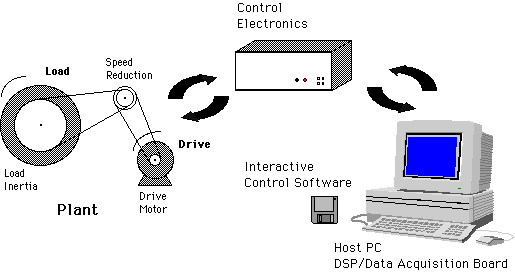Industrial Emulator Servo(IES) System Description
The Industrial Emulator Servo (IES) system is a relatively simple electromechanical system. As shown in Figure 1, the IES represents a typical servomechanism arrangement whereby a permanent-magnet DC motor drives a load through a speed reduction assembly. In this set-up, the load consists of a disk, possessing a predetermined inertia. The general operation of such a system aims to control of the angular velocity and/or position of the load; it is realized by means of a feedback control loop.

A brief description of the three components that comprise the system of Figure 1 follows. The first of these subsystems is the electromechanical plant, which consists of the emulator mechanism, its actuator and sensors. The plant design features brushless DC servo motors for drive and disturbance generation, high-resolution encoders, adjustable inertias and changeable gear ratios. It also has features to introduce coulomb and viscous friction, drive train flexibility, and backlash.
The drive motor is coupled via a timing belt to a drive disk with variable inertia. The drive disk moves one-for-one with the drive motor so that its inertia may be thought of as being collocated with the motor (for this reason, the two components have been lumped together in the drawing of Figure 1). Another timing belt connects the drive disk to the speed reduction (SR) assembly, while a third belt completes the drive train to the load disk. The load and drive disks have variable inertia, which may be adjusted with removable weights. The load inertia will rotate at a different speed than the motor (due to the SR assembly) and hence its inertia is considered to be noncollocated with the motor. Incremental rotary encoders measure the angular position of the drive and load shafts. All rotating shafts of the mechanism are supported by precision ball bearings. Friction in the bearings is considered to be viscous.
The next subsystem is the real-time controller unit, which contains the digital signal processor (DSP) based real-time controller PC board, servo/actuator interfaces, servo amplifiers, and auxiliary power supplies. The position signal is directed to a data acquisition/digital signal processing (DSP) board where a user-specified control algorithm can be implemented. The control signal is redirected, through the DSP board, to the electronics box, which powers the actuator (drive motor). The DSP is capable of executing control laws at high sampling rates allowing the implementation to be modeled as continuous or discrete time. The controller also interprets trajectory commands and supports such functions as data acquisition, trajectory generation, and system health and safety checks. A logic gate array performs motor commutation and encoder pulse decoding. Two auxiliary digital-to-analog converters (DACís) provide for real-time analog signal measurement. This controller is representative of a modern industrial control implementation.
The third subsystem is the executive program, which runs on an IBM-compatible PC under the DOS operating system. This menu-driven program is the users interface to the system and supports controller specification, trajectory definition, data acquisition, plotting, system execution commands, and more. Controllers may assume a broad range of selectable block diagram topologies and dynamic order. The interface supports an assortment of features, which provide a friendly yet powerful experimental environment.
The electromechanical apparatus may be transformed into a variety of dynamic configurations, which represent important classes of "real life" systems. The apparatus may represent many such physical plants including: 1) rigid bodies; 2) flexibility in drive shafts, gearing and belts; and 3) coupled discrete vibration with the actuator and sensor collocated at the drive input or with the sensor remotely located at a flexibly coupled output. Several other important non-ideal properties can also be introduced and removed including backlash, drive friction, and disturbances. This allows them to be characterized in a controlled manner and facilitates the study of control approaches that may mitigate their effects.